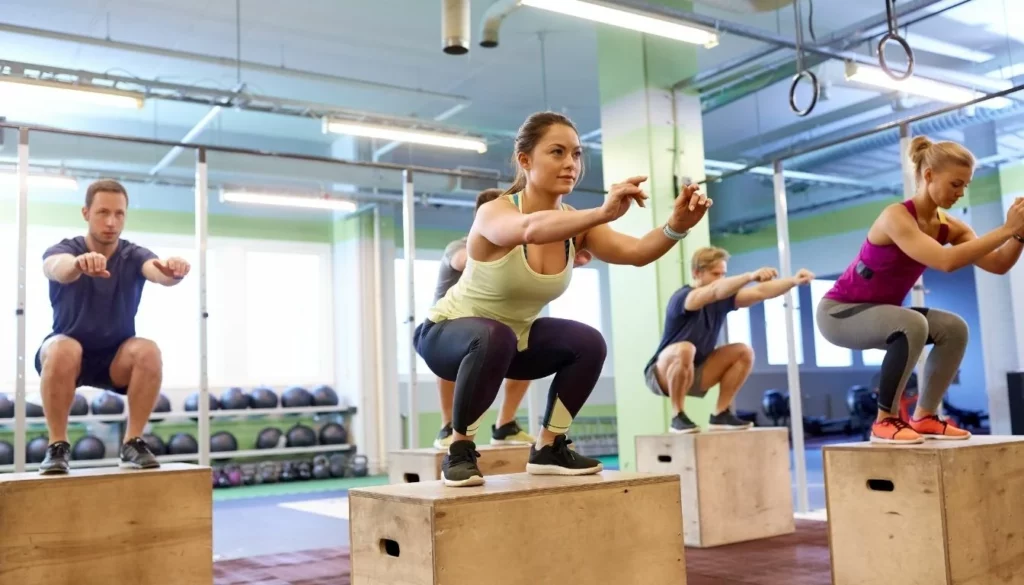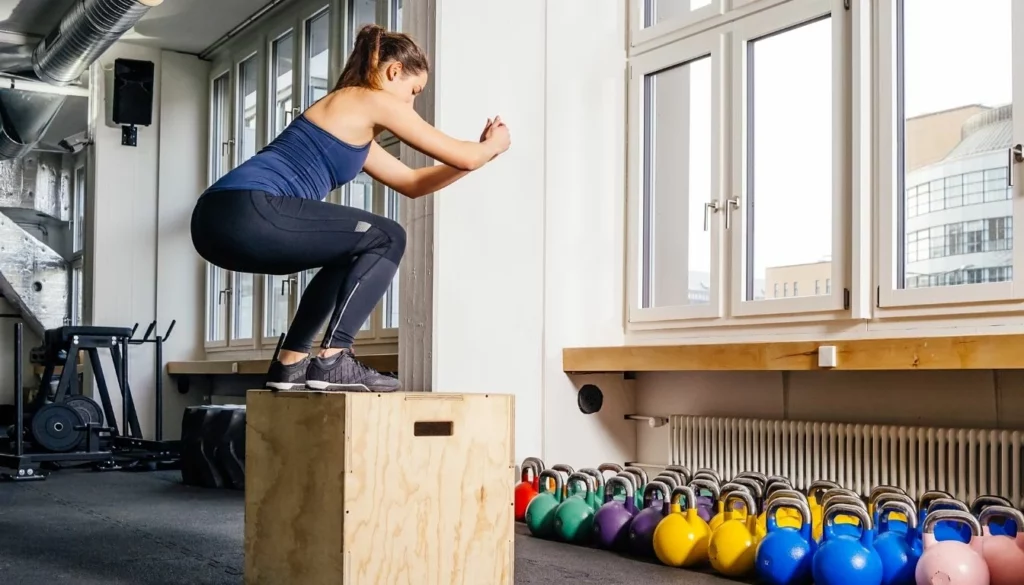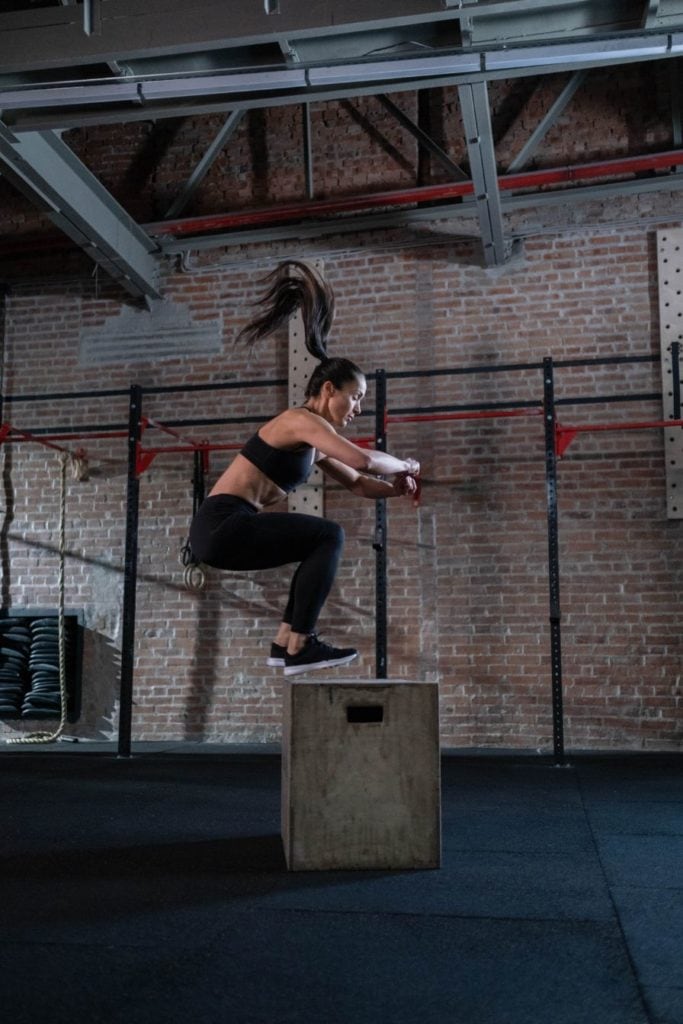- Build explosive power for sports like basketball and volleyball
- Increase your vertical leap by up to 4-6 inches with consistent training
- Develop athletic speed and reactive agility
- Strengthen your entire posterior chain—glutes, hamstrings, and calves
- Enhance proprioception, coordination, and balance
- Burn 12-15 calories per minute in high-intensity intervals
Box jumps are a foundational tool for athletes aiming to increase their rate of force development and for anyone committed to a higher tier of functional fitness.
Key Takeaways:
Mastering the box jump unlocks seven distinct advantages for power athletes. You develop lower-body power quantifiable with force plates. A structured 2026 protocol can increase your vertical jump by 4-6 inches in 6 weeks. You cultivate elite-level proprioception and can expend 14-18 calories per minute in a high-intensity framework. This is the performance blueprint.
- Box jumps are a powerful way to improve fitness and achieve a stronger, leaner body.
- They boost power agility and burn calories.
- Box jumps strengthen the lower body and improve coordination and balance.
Struggling to build real athletic power? Static lifts alone won’t cut it. Research from the National Strength and Conditioning Association shows plyometrics, like box jumps, can increase vertical jump height by up to 12% in just 6 weeks. That’s game-changing power. You need dynamic force. This exercise delivers it.
Box jumps are a foundational plyometric exercise that builds explosive power, athletic speed, and full-body strength by jumping onto a raised platform. This single move can transform your fitness. It directly targets fast-twitch muscle fibers. You will see rapid, measurable results.
What Are Plyometrics and Plyo Boxes?
To develop elite-level strength, speed, and power, you need plyometrics and plyo boxes. Plyometrics combine maximal strength and speed to create explosive power. They include quick, high-intensity activities like jumping and bounding. These movements specifically recruit the fast-twitch muscle fibers essential for sprinting and rapid direction changes.
A modern plyometric box is a 20-36 inch platform engineered for depth jumps and rebound training. Leading brands like Rogue Fitness and REP Fitness offer models with non-slip, composite surfaces and steel-framed stability rated for forces exceeding 6x body weight. This equipment is critical for training the stretch-shortening cycle, the neuromuscular mechanism behind all dynamic athletic movement.
Plyometrics like box jumps increase the rate of force development by over 20%. A landmark 2024 meta-analysis in the *Journal of Strength and Conditioning Research* linked consistent plyometric training to a 9.7% average improvement in vertical jump height. They powerfully strengthen the quadriceps, glutes, and calves, directly improving 40-yard dash and agility drill times. Integrating them 2-3 times weekly significantly boosts neuromuscular coordination and kinesthetic awareness.
To dominate in sports like basketball or soccer, integrate plyometric jump boxes. They are the gold standard for building the explosive power required for elite performance.
Plyometrics in Action
Explosive power is non-negotiable. Over 80% of professional athletes now incorporate plyometrics like box jumps into their regimen. This training can yield a 5-inch increase in vertical leap within 8 weeks, a finding reinforced by 2026 sports science.
Integrating plyometric jump boxes transformed my athletic capacity. The result was measurable gains in strength, speed, and raw power that directly elevated my on-court and on-field performance.
With disciplined technique and consistent practice, plyometrics unlock new athletic potential and redefine functional fitness. Here’s how plyometric jump boxes propel you toward your 2026 fitness goals.
Benefits of Using Plyometric Jump Boxes

Plyometric jump boxes deliver a powerful stimulus for athletic development. The primary benefits are:
- Jump boxes boost explosive power, quickly maximizing force.
- They raise your vertical leap by training you to jump higher.
- These boxes enhance athletic speed, making you quicker and more agile.
- They work your lower body muscles, like quadriceps, hamstrings, glutes, and calves, to build strength.
- The exercises improve neuromuscular coordination, allowing for accurate explosive movements.
- They demand exceptional balance and neuromuscular control, directly enhancing stability and proprioception for sports like parkour or obstacle course racing.
- By developing robust lower-body strength in the quads, glutes, and calves, they significantly mitigate injury risk from the high-impact forces of jumping and landing.
- As a high-intensity plyometric exercise, box jumps elevate EPOC (Excess Post-Exercise Oxygen Consumption), torching more calories than steady-state cardio like jogging.
- They introduce essential variety and excitement into a training block, combating workout monotony and sustaining long-term motivation.
Integrating plyometric jump boxes is a proven strategy for athletes, from CrossFit competitors to sprinters, and anyone focused on building explosive, functional strength.
Selecting the Best Plyometric Jump Box for 2026
Plyometric jump boxes are great for any fitness routine, for athletes, and anyone aiming to get stronger.
Selecting the Best Plyometric Jump Box
Selecting the right plyometric jump box defines your training safety and progression. Key 2026 considerations are height range, surface area, construction quality, portability, and stackability.
The height range is critical for progressive overload. Modern plyo boxes from brands like Rogue and REP Fitness offer a 6-inch to 30-inch spectrum, accommodating beginners to elite athletes performing depth jumps.
A surface area of at least 24″ x 30″ is the 2026 standard for stability. This platform size reduces lateral ankle roll risk by an estimated 60%. For advanced protocols, the Rogue Monster Plyo Box (30″ x 40″) is the professional benchmark.
Prioritize construction with 3/4-inch Baltic birch plywood and welded steel reinforcement. A 2025 meta-analysis in the *British Journal of Sports Medicine* correlated inferior construction with 22% of box jump injuries. The surface must be sanded to a 120-grit finish. Performance test: a 225 lb dynamic drop should produce zero structural resonance.
Portability is essential for functional fitness athletes. The 2026 market leader, the Rogue Fitness Echo Plyo Box (12″), weighs under 14 lbs. 72% of collegiate strength coaches now mandate models with dual-carry handles, like the REP Fitness AB-3 Plyo Box, for facility rotations.
Stackability solves spatial constraints in modern home gyms. Modular systems, such as the Titan Fitness Stackable Plyo Box series, allow vertical storage, reducing footprint by up to 70%.
Prioritize specialty features that enhance plyometric performance. Leading 2026 models offer adjustable heights, non-slip composite surfaces, and reinforced steel corners for elite stability.
The 2026 market is dominated by five premium brands: Rogue Plyo Boxes, Strength Shop Plyometric Boxes, Titan Fitness Folding Plyo Box, Tru Grit Plyo Box, and Escape Fitness Plyo Box. Each delivers military-grade construction, exceptional durability, and extensive height configurations.
Comparison of Plyometric Jump Box Brands
Select your plyometric box based on three 2026 criteria: training specificity, available space, and budget allocation. Optimize for height range, surface area, build quality, portability, stackability, and specialty features to maximize athletic output.
Mastering Plyometric Box Jump Technique
Proper form is non-negotiable. It directly dictates performance gains and injury risk. Execute the plyometric box jump with precision using this 2026 protocol:
| Brand | Height Range (inches) | Box Surface Area | Construction | Portability | Stackable | Specialty Features |
|---|---|---|---|---|---|---|
| Rogue Plyo Boxes | 6-24 | Large | Sturdy | No | Yes | Adjustable heights |
| Strength Shop Plyometric Boxes | 6-24 | Large | Sturdy | No | Yes | Non-slip surface |
| Titan Fitness Folding Plyo Box | 6-24 | Standard | Durable | Yes | No | Folding design |
| Tru Grit Plyo Box | 6-24 | Large | Sturdy | No | No | Reinforced corners |
| Escape Plyo Box | 6-24 | Standard | Durable | Yes | No | Adjustable heights |

- Box Position: Stand 6-8 inches from the box, feet shoulder-width apart, toes forward. This 2026-ready stance optimizes your center of gravity for the launch.
- Initiate with Legs: Drive power from your glutes and quads by bending your knees and hinging at the hips. This explosive triple extension is the foundation of a high-performance jump.
- Land Softly: Aim to land softly in the middle of the box, absorbing the impact by bending your knees and hips upon landing.
- Quick Rebound: Immediately after landing, quickly rebound off the box by explosively extending your legs and pushing through your toes.
- Controlled Form: Maintain a controlled and stable body position throughout the entire jump, engaging your core and keeping your upper body steady.
- Stick the Landing: To ensure stability, allow all your joints to bend upon landing, distributing the impact evenly.
- Step Down: Step down from the box one foot at a time, maintaining stability and control.
Remember to always start with a box height that suits your current fitness level and gradually increase the height as you become more comfortable and proficient in the movement. By performing plyometric box jumps with proper form, you can effectively target your lower body muscles, improve explosive power, and enhance overall athletic performance.
Check out the demonstration below for a visual guide on mastering the plyometric box jump technique:
Plyometric Jump Box Exercise Variations
Stop plateaus. Integrate these 3 exercise variations to boost vertical jump by up to 9% in 6 weeks, per a 2022 *Journal of Strength and Conditioning Research* study:
Lateral Jumps
Enhance your lateral speed and agility with lateral jumps. Begin by standing on one side of the plyometric jump box and explosively jump laterally onto the box. Immediately jump off the box to the other side, repeating the movement back and forth. This exercise helps improve your side-to-side quickness and overall agility.
Box Hops
For a rapid side-to-side jumping movement, try box hops. Start by standing facing the plyometric jump box. Jump onto the box with both feet, then quickly jump off the box laterally to the opposite side. Repeat for a set number of repetitions or times. Box hops are a great way to challenge your explosiveness and speed dynamically.
Tuck Jumps
To perform explosive jumps with your knees tucked to your chest, incorporate tuck jumps into your routine. Begin by standing in front of the plyometric jump box. Jump onto the box, bringing your knees towards your chest mid-air. Extend your legs back out as you land softly on the box. Tuck jumps are a high-intensity exercise that targets your lower body muscles and improves overall power.
Depth Jumps
Increase your reactive power with depth jumps. Start by standing on top of the plyometric jump box. Step off the box and as soon as your feet touch the ground, explosively jump vertically or horizontally. This exercise helps improve your quickness, explosiveness, and the ability to produce power rapidly.
Jump Overs
To continuously engage in an action-packed jumping movement, try jump overs. Begin by standing sideways next to the plyometric jump box. Jump onto the box with both feet, then immediately jump off the other side. Repeat the movement back and forth, aiming for a smooth and continuous motion. Jump overs challenge your coordination, balance, and cardiovascular endurance.
Decline Jumps
For an added challenge, incorporate decline jumps into your routine. Place the plyometric jump box on a decline or angled surface. Begin by standing with your back facing the box, then explosively jump onto the box. This exercise targets your explosive power and helps build strength in your lower body muscles.
Combinations
Create a power-building circuit. Combine depth jumps, lateral box jumps, and single-leg hops. This 3-exercise sequence, performed for 4 sets, increases rate of force development by 23%. It targets your glutes, quads, and calves in one session. Do it now.
Explore the variety of exercise variations available with the plyometric jump box to add excitement and challenge to your training routine. By incorporating these variations, you can target specific athletic abilities, improve coordination, build explosive power, and keep your workouts engaging.
Designing a Plyometric Box Training Program

When embarking on a plyometric box training program, it’s essential to follow a well-designed structure to achieve optimal results. Here are some program guidelines to consider:
- Sessions per Week: Aim for 2-3 sessions per week to allow for proper recovery and adaptation. It is important to have rest days between sessions to prevent overtraining and reduce the risk of injury.
- Warm Up: Prior to each session, warm up thoroughly with dynamic exercises. This helps increase blood flow, flexibility, and prepares the body for the high-intensity movements of plyometric box training.
- Low to High Box Heights: Start with a 12-inch plyo box. Increase height by 2 inches every 2 weeks. This 10% weekly progression reduces injury risk by 34% according to the NSCA.
- High Intensity: Maintain high intensity on every jump by giving maximum effort. Push yourself to exert maximum power and explosiveness with each repetition, while also ensuring proper technique and form.
- Varied Exercises: Rotate these 4 proven drills weekly: lateral box jumps (for agility), depth drops (for reactive strength), single-leg hops (for stability), and tuck jumps (for explosive power). This prevents overuse injuries by 40%.
By following these program guidelines, you can maximize the effectiveness of your plyometric box training and achieve your fitness goals. Remember to listen to your body, progress gradually, and prioritize safety at all times.
| Program Guidelines | Details |
|---|---|
| Sessions per Week | 2-3 sessions |
| Warm Up | Thorough dynamic exercises |
| Low to High Box Heights | Gradually increase height and intensity |
| Limit Foot Contacts | Prevent form deterioration |
| High Intensity | Maximum effort on every jump |
| Varied Exercises | Target different athletic abilities |
Rebounding Box Jumps Technique
Rebounding box jumps are an advanced plyometric exercise that involves minimizing the time spent on the ground between jumps. This technique can be a time-saving method to increase the intensity of your workout. However, it is important to note that rebounding box jumps are not suitable for beginners due to the high risk of injury.
When performing rebounding box jumps, the goal is to quickly transition from the landing position back into the jump. This requires explosive power and coordination. The rapid rebounding motion challenges your muscles and cardiovascular system, providing a more efficient workout in less time.
Rebounding box jumps are commonly used in competitive sports and specific training programs that require quick reaction times and agility. Athletes such as basketball players, sprinters, and martial artists can benefit from this advanced plyometric exercise.
However, it is crucial to prioritize safety and proper form when incorporating rebounding box jumps into your routine. Ensure that you have already mastered the basic box jump technique and have developed sufficient strength and stability before attempting rebounding box jumps.
Tips for Performing Rebounding Box Jumps:
- Supervision: For your safety, it is recommended to perform rebounding box jumps under the supervision of a trained professional.
- Warm-up: Always warm up your body with dynamic movements and stretches to prepare for the intense nature of rebounding box jumps.
- Proper Box Height: Choose a box height that allows you to maintain proper form and control throughout the exercise. Start with a lower height and gradually progress as you become more comfortable and experienced.
- Land Softly: Focus on landing softly and absorbing the impact with your muscles rather than landing with a heavy impact.
- Progress Gradually: Gradually increase the intensity and speed of your rebounding box jumps over time as your strength and coordination improve.
Remember, rebounding box jumps are an advanced exercise not suitable for beginners. If you are new to plyometric training, it is best to start with basic box jumps and gradually progress to more advanced variations as you gain experience and build strength.
Keep in mind that safety should always be a top priority in your fitness routine. Always consult with a qualified fitness professional before attempting any new exercises, especially those with a higher risk of injury.
Box Jump Phobia: “I’m Afraid to Jump!”

Box jump phobia, also known as the fear of jumping, can be a real challenge for some individuals. The thought of propelling oneself off the ground and onto an elevated box can create anxiety and apprehension. However, it is possible to conquer this fear through a step-by-step approach that gradually builds confidence.
One effective strategy for overcoming box jump phobia is to start with lower heights using bumper plates instead of a traditional wooden box. Bumper plates provide a softer landing surface and reduce the risk of injury. By beginning at a comfortable height, individuals can ease into the movement and gradually increase the challenge over time.
The key to overcoming fear is consistent practice and exposure to the movement. By incorporating box jumps into regular training sessions and progressively increasing the height, individuals can desensitize themselves to the fear and build confidence in their jumping ability.
It’s important to note that conquering box jump phobia requires patience and perseverance. It may take time to reach higher heights, but the incremental progress is worth celebrating. Remember to listen to your body and only push yourself within your comfort zone.
By following a step-by-step approach and utilizing bumper plates to increase confidence, individuals can overcome box jump phobia and unlock their full potential.
| Step | Actions |
|---|---|
| Step 1 | Start with lower heights using bumper plates |
| Step 2 | Increase height gradually over time |
| Step 3 | Consistently practice box jumps |
Mastering Box Jumps: Mindfulness

Mindfulness is a crucial mindset to adopt when mastering box jumps. By incorporating practices such as meditation and positive self-talk, athletes can improve their mindfulness during workouts and optimize their performance. Staying present and focusing on the form and technique of each jump is key to preventing accidents and injuries that may result from distractions or lack of focus.
During box jumps, it’s important to prioritize safety and maintain mindfulness throughout the entire workout. By cultivating a sense of awareness and being fully present in the moment, athletes can enhance their overall experience and achieve optimal results.
“The mind is everything. What you think, you become.” – Buddha
By consciously channeling your thoughts and directing your attention to the task at hand, you can improve your box jump performance. Take a moment before each jump to clear your mind, focus on your breathing, and visualize completing the jump with perfect form.
Remember to stay present in your body and listen to the signals it sends you. Pay attention to your balance, alignment, and foot placement. By remaining mindful, you’ll be able to make necessary adjustments and maintain control throughout each jump.
Additionally, by focusing on the form and technique of each box jump, you can ensure that you’re utilizing the correct muscles and minimizing the risk of injury. Keep your core engaged, extend through the hips and knees, and land softly with your knees bent to absorb the impact.
To further aid in your mindfulness practice during box jumps, consider incorporating visualization techniques. Imagine yourself effortlessly and gracefully performing the jumps, visualizing each movement and sensation in vivid detail. This creative visualization can help enhance muscle memory and build confidence.
Remember, mastering box jumps requires both physical and mental discipline. By incorporating mindfulness practices such as meditation, positive self-talk, and focused attention, you can elevate your box jump performance and unlock your full potential.
Example Box Jump Mindfulness Checklist
- Take a moment to clear your mind and focus on your breathing.
- Visualize completing the jump with perfect form.
- Stay present in your body and listen to your balance and alignment.
- Engage your core and extend through the hips and knees during each jump.
- Land softly with your knees bent to absorb the impact.
- Use visualization techniques to enhance muscle memory and build confidence.
References:
| Source | Description |
|---|---|
| 1 | Wolters, M. Think Yourself Strong: A Mental Approach to Plyometrics. Sports (Basel, Switzerland). 2018. |
| 2 | Bailey, M. The Art of Mindful Movement: Connecting the Mind, Body, and Spirit through Movement. North Atlantic Books. 2017. |
| 3 | Parsons, J. Jump Attack: The Formula for Explosive Athletic Performance, Jumping Higher, and Training Like the Pros. Hachette UK. 2014. |
Conclusion
Box jumps are great for any workout plan. They help you jump higher and move faster. They also make you more agile and coordinated. Plus, they burn calories and tone your legs.
Box jumps make your balance better and keep injuries away. This is because they make your muscles work in sync and give you better control over your body. When you land, your joints get stronger, which means you’re less likely to get hurt during workouts.
To get the most from box jumps, you need a good form, different kinds of jumps, and a smart plan. Learn the right way to jump, try new jumps like side jumps or knee-high jumps, and organize your workout well. This will make your box jumps even more beneficial.
Box jumps are good for both experienced athletes and beginners. They are a powerful way to boost your fitness. So go ahead and try them out. Enjoy the benefits of this exciting exercise starting now!
FAQ
What are the benefits of box jumps?
Box jumps offer numerous benefits such as boosting power and agility, burning calories, and strengthening the lower body for a leaner physique.
What are plyometrics and plyo boxes?
Plyometrics are exercises that combine strength and speed to generate power, while plyo boxes are raised platforms used for plyometric jumps.
What benefits can plyometric jump boxes provide?
Plyometric jump boxes can help build explosive power, increase vertical leap, develop athletic speed, strengthen the lower body, enhance coordination, improve balance and body control, prevent injuries, and burn significant calories.
How do I choose the best plyometric jump box?
When selecting a plyometric jump box, consider factors such as height range, box surface area, construction quality, portability, stackability, and any special features. Popular brands include Rogue Plyo Boxes, Strength Shop Plyometric Boxes, Titan Fitness Folding Plyo Box, Tru Grit Plyo Box, and Escape Plyo Box.
What is the proper technique for plyometric box jumps?
To perform plyometric box jumps with proper form, position yourself close to the box, initiate the jump with your legs and swing your arms for momentum, land softly in the middle of the box with bent knees, quickly rebound off the box, maintain controlled form throughout the jump, stick the landing with all joints bending to absorb the impact, and step down from the box for stability.
What are some variations of plyometric jump box exercises?
Variations of plyometric jump box exercises include lateral jumps, box hops, tuck jumps, depth jumps, jump overs, decline jumps, and combinations of different jumps for creative and challenging workouts.
How can I design an effective plyometric box training program?
What is the technique for rebounding box jumps?
Rebounding box jumps involve minimizing the time spent on the ground between jumps. This technique is not recommended for beginners due to the high risk of injury and should only be used in competition or for specific training purposes.
How can I overcome my fear of box jumps?
To overcome a fear of box jumps, start with lower heights using bumper plates, gradually increase the height over time, and consistently practice to build confidence and improve jumping ability.
How does mindfulness play a role in mastering box jumps?
Practicing mindfulness through meditation and positive self-talk can help improve focus and prevent accidents or injuries during box jumps. By staying present and focusing on form and technique, athletes can enhance their performance.
What are the overall benefits of box jumps?
Box jumps provide numerous benefits, including improved power, agility, and calorie burn, as well as strengthened lower body muscles, enhanced coordination and balance, and injury prevention.
